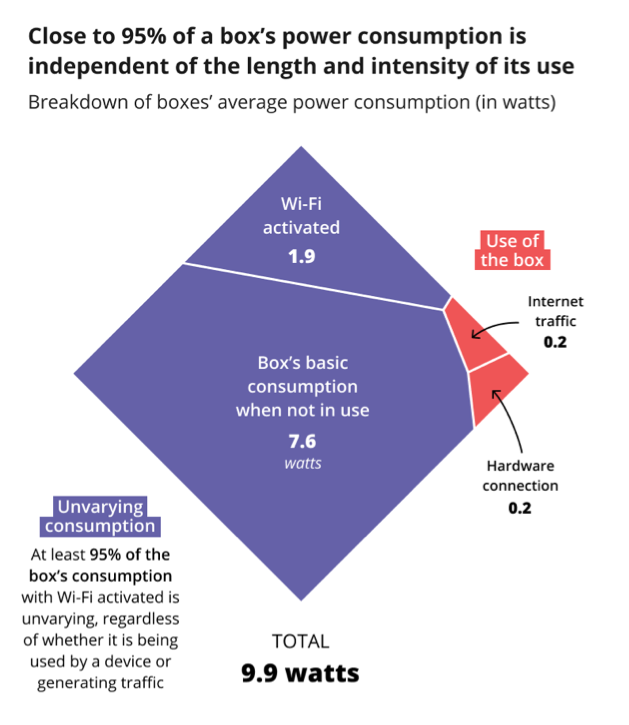Mobile networks are driving up energy use, says French regulator
French operators' Scope 1 and 2 emissions increased by 2% in 2022 as energy consumption of mobile networks continued to grow, according to data from the country's regulator Arcep.

In 2022, the cumulative Scope 1 and 2 emissions of French operators Bouygues, Free, Orange and SFR rose by 2% for a second year in a row, according to data from French regulator Arcep.
The latest edition of Arcep's annual inquiry titled "Achieving digital sustainability" collates indicators on emissions and environmental performance of the digital sector, spanning telecommunications networks, data centers and certain kinds of devices.
While Scope 1 data refers to energy consumed directly by a company, such as through its vehicle fleet or by running boilers, Scope 2 refers to indirect emissions from the energy it purchases. The latter category can be measured in two different ways.
The first, called "location-based," only considers the overall energy mix in a given area when calculating emissions tied to energy bought from the grid. Meanwhile, the so-called market-based approach takes into account market mechanisms like renewable energy certificates, making it easier for companies to reach a reduction in reported emissions.
The 2% increase reported by Arcep is based on location-based Scope 2 emissions, which rose by 3%. The regulator also points out that the increase in emissions in 2022 and 2021 comes after a large pandemic-induced drop in 2020.
In the full report (available in French), the regulator also discloses that operators' market-based Scope 2 emissions fell by 5% in 2022 and were 25% lower than their location-based emissions, providing interesting insight into how much the two metrics can differ.
Growing data traffic impacts energy demand
Arcep reports that operators' energy consumption continued to grow, registering a 7% increase in 2022. This was due mainly to the rising energy consumption of mobile networks, which grew by 14% in 2022. Arcep attributes this to a 28% increase in mobile data consumption and the addition of 7,300 mobile sites in the same year.
Data traffic is expected to continue growing worldwide, which means that the amount of power consumed by mobile networks is unlikely to fall anytime soon. While 5G networks are more energy efficient per unit of data, their greater capacity means they tend to consume more power overall than 4G. McKinsey, for example, expects data consumption to grow exponentially over the next five years, saying this will likely offset the benefits gained by using more energy-efficient data transmission protocols.
The good news, however, is that many operators worldwide are opting for renewable electricity. According to the GSMA, the share of renewable electricity used by operators disclosing to CDP, a nonprofit that tracks organizations' environmental impact, rose from 14% in 2019 to 33% in 2022. It is worth noting that this group of operators represents around 55% of mobile connections globally. In France, all operators apart from Altice (the parent company of SFR) made disclosures to CDP in 2022 and 2023.
Falling for fiber
Arcep, meanwhile, reports that energy consumption on France's fixed networks fell by 14% in 2022, mainly because of the continuing transition from copper to optical fiber. The regulator's data has also previously shown that an optical fiber subscription is typically less energy intensive than a mobile one.
Power consumption of fixed networks was also dwarfed by that of Internet and set-top boxes, which was three times greater during the measured period.
While network energy consumption is dictated by data traffic, this factor has very little impact when it comes to electricity used by Internet and set-top boxes. Across devices, around 95% of their consumption happens regardless of whether they are being used. At the same time, Arcep notes that energy efficiency varies significantly from one device to another.

(Source: Arcep)
When it comes to user devices, the data shows that sales fell across all of the categories included – mobile phones, laptops, computer screens, TVs and tablets. But the sustainability benefits might be at least partially offset by increasing screen sizes across nearly all categories, except TVs.
Nevertheless, Arcep reports that Scope 1 and 2 emissions of surveyed device manufacturers fell by 5.4% in 2022. The collected data covers 70% to 95% of devices on the French market, depending on the category, meaning it does not exactly present a complete picture. The regulator has, however, signaled plans to expand the data it collects in future editions of the report.
Data center challenges
One way to limit the environmental impact of user devices is by increasing the share of refurbished equipment. And while demand for refurbished handsets has been on the rise in Europe, the proportion of refurbished handsets sold by French telcos shrank by 9% to reach 4% in 2022. This is far behind other sales channels, where refurbished devices represented 25% of the total, according to Arcep.
In contrast, emissions linked to data center operators in France grew by 14% in 2022, while their energy consumption increased by 15%. This was in large part due to increasing capacity, but also high temperatures registered that year, which increased the need for equipment cooling. Arcep notes that the energy efficiency of data centers varies, with larger and newer ones generally performing better on environmental indicators.
While data center water consumption rose by 20%, Arcep noted that this still represents only a small share of overall water use associated with industrial and economic activity.
The findings are in line with other indicators on data center sustainability. While the sector has made advances in energy efficiency, its overall power and water footprint is still cause for concern. The International Energy Agency (IEA) sums up the sector's environmental performance worldwide as "more efforts needed."
Read more about:
EuropeAbout the Author(s)
You May Also Like




_International_Software_Products.jpeg?width=300&auto=webp&quality=80&disable=upscale)







